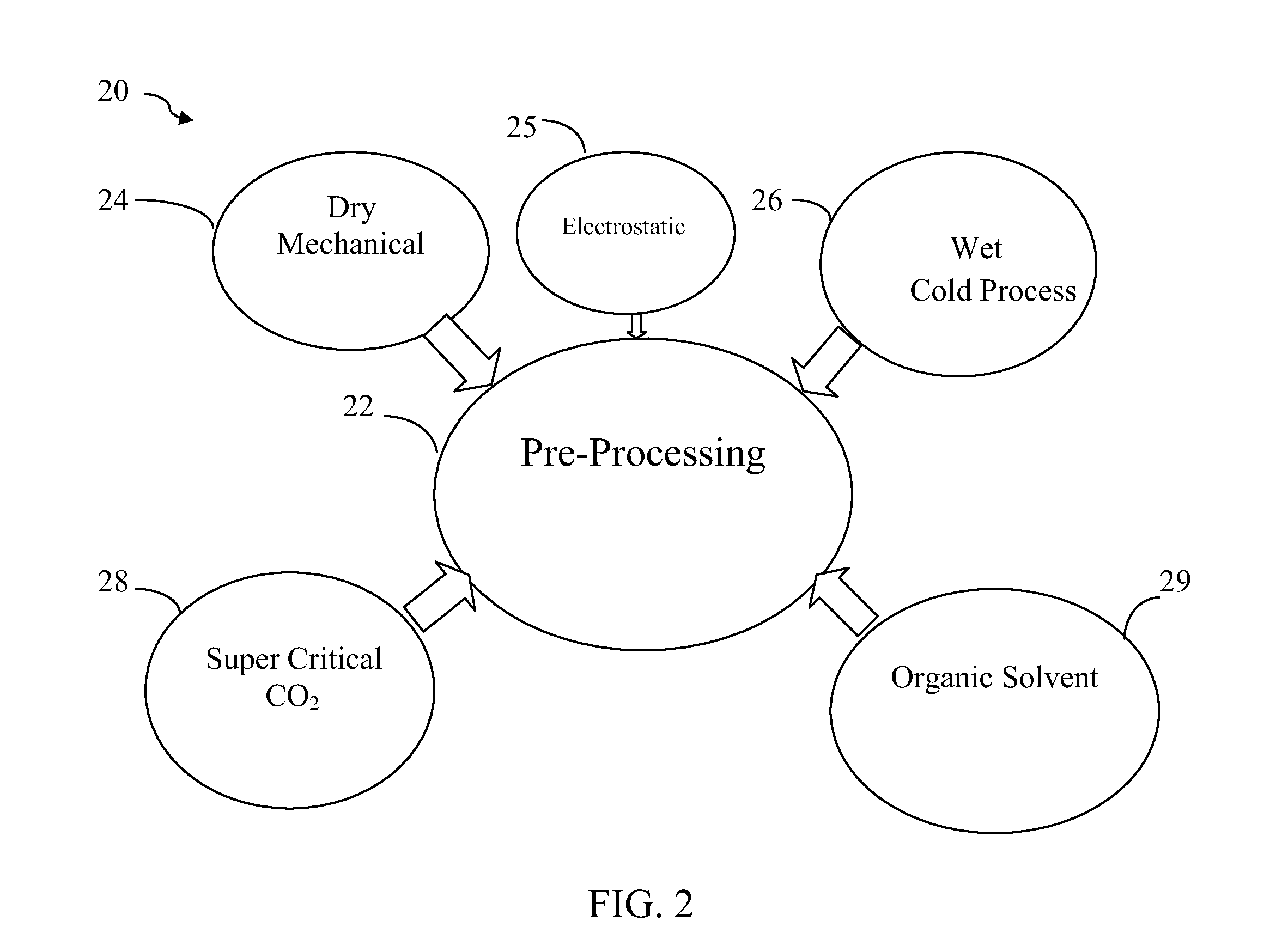Method for modifying THC content in a lipid-based extract of cannabis
a technology of lipid-based extracts and cannabinoids, which is applied in the direction of non-active ingredients, biocide, oil/fat/waxes, etc., can solve the problems of reducing yield, reducing psychoactivity, and reducing the therapeutic effect of isolated cannabinoids, so as to reduce psychoactivity, improve production efficiency, and reduce the effect of th
- Summary
- Abstract
- Description
- Claims
- Application Information
AI Technical Summary
Benefits of technology
Problems solved by technology
Method used
Image
Examples
example 1
[0082]Mix 1600 grams of dried cannabis substrate (leaves and flowers), ½ gallon of coconut oil, and 4 gallons of water. This yields an approximate ratio of 1:8 lipid oil to water. This ratio produces a concentration of no less than 25 mg of nearly full spectrum extracted cannabinoids per 1 ML of coconut oil. The final extracted oil can then be encapsulated, and taken internally, or applied topically. A capsule could be made of gelatin, plant cellulose, or combined with starch into a pressed pill.
[0083]Stage 1:[0084]A. Mix 1600 grams of dried cannabis, ½ gallon of coconut oil, and 4 gallons of water is added to the pressure cooker. Heat under pressure at 15 psi at 121° C. degrees for 6 hours.[0085]B. Reduce heat and pressure to 7 psi above atmospheric at 107° C. for an additional 14 hours.[0086]C. The vessel is brought down to atmospheric pressure at 93° C.[0087]D. Saturated substrate is then squeezed of all liquid using mechanical pressure.[0088]E. All liquid is saved and put in a s...
example 2
Post Processing to Decarboxilate and Reduce THC
[0129]A. After STAGE 3 is complete and the coconut oil congeals and separates from the water, place congealed coconut oil in a clean stainless steel pot. Heat oil rapidly to above 141° C., preferably above the vaporization temperature of THC i.e. 157° C. and below the vaporization temperature of CBD, which is between 160-180° C. This process will remove any remaining water content in the oil and volatilize a portion of THC contained in the concentrated cannabis product.[0130]B. Continue heating the oil at 121° C. for an additional 10 min to activate cannabinoids, causing most of any remaining non-decarboxilated portion of the cannabinoids to decarboxilate.[0131]C. Allow the oil to cool to 82° C. and pour through a filter no greater than 20 microns.[0132]D. The oil should be nearly 100% water free and most cannabinoids will be decarboxilated. Concentration of cannabinoids in the cannabinoid product is preferably no less than 25 mg of can...
example 3
Post Processing to Increase CBD:THC Ratio
[0134]A. After STAGE 3 is complete and all oil separated, place congealed coconut oil in a clean stainless steel pot. Heat oil rapidly to above 141° C., preferably above the vaporization temperature of THC i.e. 157° C. and below the vaporization temperature of CBD, which is between 160-180° C. This process will remove the remaining water content in the oil and some THC content will be volatilized. Although some CBD may be volatilized, preferably the cannabis substrate used in the various extraction stages is from a hemp strain containing at least a 8:1 ratio of CBD:THC so even with some degradation of CBD, there is a significant residual amount of CBD in the cannabinoid mix[0135]B. Continue heating the oil at 132° C. for an additional 10 min to convert a portion of THC to CBN.[0136]C. Allow the oil to cool to 82° C. and pour through a filter no greater than 20 microns.[0137]D. The oil should be 100% water free and most cannabinoids will be de...
PUM
| Property | Measurement | Unit |
|---|---|---|
| pressure | aaaaa | aaaaa |
| pressures | aaaaa | aaaaa |
| pressure | aaaaa | aaaaa |
Abstract
Description
Claims
Application Information
 Login to View More
Login to View More - R&D
- Intellectual Property
- Life Sciences
- Materials
- Tech Scout
- Unparalleled Data Quality
- Higher Quality Content
- 60% Fewer Hallucinations
Browse by: Latest US Patents, China's latest patents, Technical Efficacy Thesaurus, Application Domain, Technology Topic, Popular Technical Reports.
© 2025 PatSnap. All rights reserved.Legal|Privacy policy|Modern Slavery Act Transparency Statement|Sitemap|About US| Contact US: help@patsnap.com



